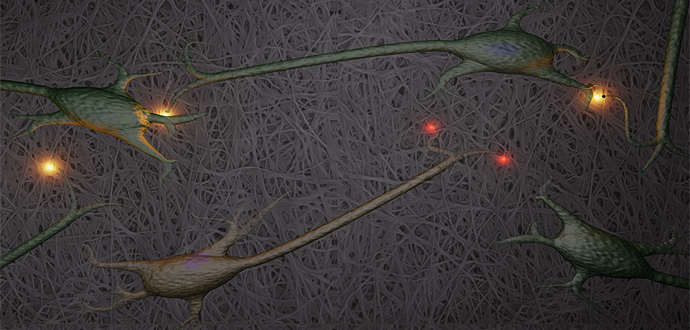First step toward creating a 3D artificial brain
March 20, 2012

Nerve cells growing on a three-dimensional nanocellulose scaffold. Functioning synapses are yellow; the red spots show where synapses have been destroyed (credit: Philip Krantz, Chalmers)
Researchers from Chalmers University of Technology and the University of Gothenburg have taken the first step in creating a three-dimensional model of the brain by attaching neurons to a positively charged nanocellulose scaffold.
The purpose is to understand Alzheimer’s disease and Parkinson’s disease better, for example.
Nitrocellulose (microfibrillated cellulose) is obtained from plant materials, such as woodpulp.
‟Pores can be created in nanocellulose, which allows nerve cells to grow in a three-dimensional matrix. This makes it extra comfortable for the cells and creates a realistic cultivation environment that is more like a real brain compared with a three-dimensional cell cultivation well,” says Paul Gatenholm, Professor of Biopolymer Technology at Chalmers.
The researchers found in their experiments that neurons began to develop and generate synapses (contacts with one another) and a neural network of hundreds of cells was produced. The researchers could then use electrical impulses and chemical signal substances to generate nerve impulses that spread through the network in much the same way as they do in the brain. They could also study how nerve cells react with other molecules, such as pharmaceuticals.
Initially the group wants to investigate destruction of synapses between nerve cells, one of the earliest signs of Alzheimer’s disease. They also want to study how cells react to the patients’ spinal fluid. In the future, this method may be useful for testing various pharmaceutical candidates that could slow down the destruction of synapses.
Gatenholm says that there are a number of new biomedical applications for nanocellulose. He is currently leading other projects that use the material, such as using nanocellulose to develop cartilage to create artificial outer ears. His research group has previously developed artificial blood vessels made of nanocellulose, which are being evaluated in pre-clinical studies.
The results will be presented at the American Chemical Society Meeting in San Diego on March 25.